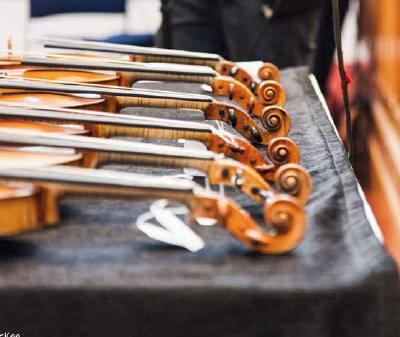Notable Sales: Nicolò Amati
At the beginning of the 1630s Nicolò Amati found himself to be practically the only notable violin maker in Italy. The plague of 1630-31 had claimed his father, Girolamo, as a victim, as well as Giovanni Paolo Maggini in Brescia. Thus, it was left to Nicolò to continue the Amati family business and to uphold its violin-making tradition. The instruments illustrated in our archive cover the breadth of Nicolò’s output over his long working life, which spanned more than 60 years.
Nicolò adapted and improved on his father’s work, developing the ‘Grand Pattern,’ which is perhaps his most significant contribution to the acoustics of the violin (see a violin circa 1683). His immaculate craftsmanship can be seen in the 1635 example, which also demonstrates the quality of the wood that he had at his disposal this early in his career. The 1640s and 50s are considered the pinnacle of his career, and from about 1670 he progressively entrusted most of the work to his son, Girolamo.
Nicolò’s great legacy is as a teacher, and his apprentices in the years 1640-1670 included Andrea Guarneri, G.B. Rogeri, Giacomo Gennaro and possibly Jacob Stainer. Recent research suggests that Francesco Ruggieri and Antonio Stradivari were never apprentices in the Amati household, but they were undoubtedly acquainted with his methods and influenced by his style. It would be more accurate to describe Stradivari as a follower of Nicolò Amati rather than a pupil, but it is still true to say that it was Amati’s work that inspired the two great violin-making families of Stradivari and Guarneri.
(Cremona, b 1596; d 1684)
At the beginning of the 1630s Nicolò Amati found himself to be practically the only notable violin maker in Italy. The plague of 1630-31 had claimed his father, Girolamo, as a victim, as well as Giovanni Paolo Maggini in Brescia. Thus, it was left to Nicolò to continue the Amati family business and to uphold its violin-making tradition. The instruments illustrated in our archive cover the breadth of Nicolò’s output over his long working life, which spanned more than 60 years.
Nicolò adapted and improved on his father’s work, developing the ‘Grand Pattern,’ which is perhaps his most significant contribution... Read more
03 March 2025
We examine the 1665 ‘ex-Wilfred Hepton’ Nicolò Amati violin in our March sale, its brush with royalty, and its link to a musical charity in Cleveland, Ohio
26 April 2021 - Dilworth, John
The Evolution of Violin Making from 16th-20th Century Part V
19 April 2021 - Dilworth, John
The Evolution of Violin Making from 16th-20th Century Part IV
19 April 2021 - Dilworth, John
The Evolution of Violin Making from 16th-20th Century Part III
12 April 2021 - Dilworth, John
The Evolution of Violin Making from 16th-20th Century Part II
12 April 2021 - Dilworth, John
The Evolution of Violin Making from 16th-20th Century Part I
We offer buyers and sellers a bespoke private sale service, sourcing exceptional instruments and bows and matching them with the most discerning buyers.
More InformationTim Ingles and Paul Hayday will offer an initial evaluation of the authenticity and value of your instrument or bow to recommend an auction estimate and reserve price.
Enquire
Tim Ingles and Paul Hayday will offer an initial evaluation of the authenticity and value of your instrument or bow. At this stage, the assessment is free and without obligation. In the first instance, we suggest submitting good-quality images to us, preferably by email to info@ingleshayday.com or by completing the valuation form.
Read more